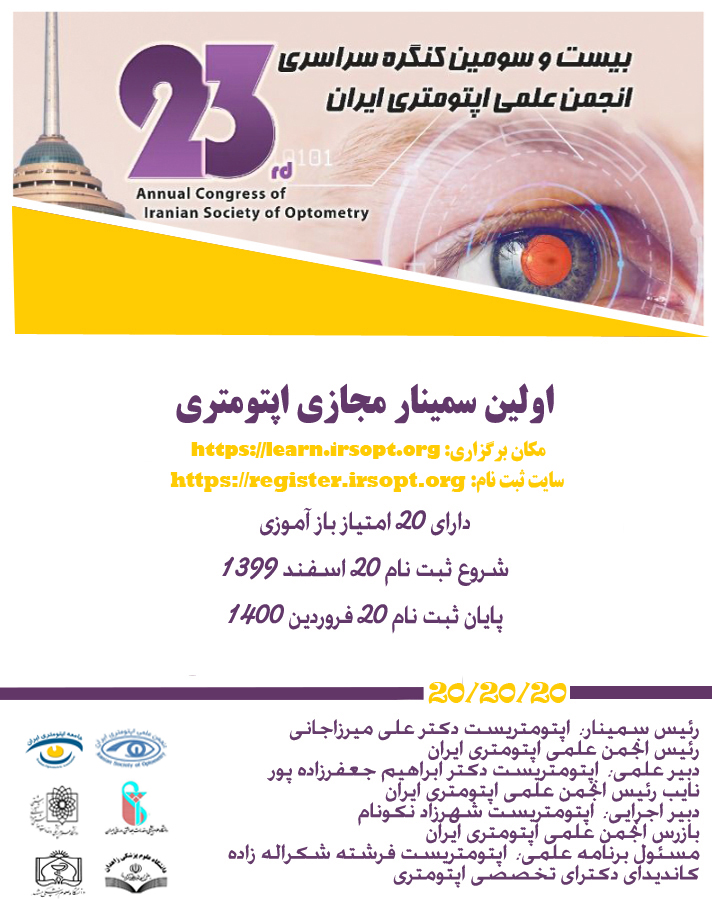
RECOGNISING GLAUCOMA EMERGENCIES

Consultant ophthalmologist Dilani Siriwardena discussed the most common emergencies that can arise in glaucoma patients.
Gracing the Main Stage on Monday (February 9), Ms Siriwardena provided a clinical overview of the sight-threatening glaucoma emergencies that can present in routine practice.
Delegates were advised of the key signs and symptoms to expect with bleb-related infections and stressed that “optometrists play an important role in identifying these cases at the earliest stage to give the best outcome for the patient.”
Detail was given on how to recognise blebs that are vulnerable to infection, underlining the fact that these patients, “can present with relatively mild symptoms but progress very quickly to endophthalmitis within a matter of hours, resulting in devastating consequences.” Practitioners were made aware of the hallmark ‘white on red’ sign in these cases where the white appearance of the bleb is surrounded by an area of significant hyperaemia.
Ms Siriwardena turned her attention to the recognition of closed-angle glaucoma providing delegates with a revision of the classic signs and symptoms of haloes, headaches, nausea, fixed pupil, corneal oedema and elevated intraocular pressure. She emphasised the importance of undertaking a careful van Herick assessment to identify patients at risk of closed-angle attack.
In the final segment of the talk the ophthalmologist gave a brief overview of the advances in modern surgical approaches to glaucoma treatment but conceded that we are still striving to find, “the Holy Grail of 10-10-10 for treatment – a procedure that would take 10 minutes to do, result in an intraocular pressure of 10mmHg and cost £10.”
CONTACT LENSES THROUGH THE GENERATIONS
Caroline Christie explored how a patient’s contact lens needs change throughout their life
In an entertaining session on Monday (February 9), optometrist Caroline Christie gave a Doctor Who-themed talk by considering the contact lens requirements of patients at different points in their life cycle.
The talk, entitled Generation XYZ: a lifetime of contact lenses, a journey through space and time, started by considering ‘Generation Z,’ those patients born around 1997, characterised as being not only Internet savvy but also “the driving force behind parents’ buying decisions.” Ms Christie highlighted that children were good candidates for contact lens wear, allowing the opportunity for refractive correction to be kept up to date and had the support of parents to assist with compliance.
The optometrist gave food for thought by recognising the growing evidence for the role of myopia control using dual focus contact lenses and orthokeratology.
On the whistle stop tour through the ages, Ms Christie turned her attention to ‘Generation Y,’ which she defined as patients born between 1977 and 1996. She realistically described this group of patients as typically showing less loyalty, and as those who were prepared to purchase products online and more likely to avoid attending aftercare appointments. As these patients may also be considering refractive surgery, often for reasons related to contact lens issues, she stressed the importance of retaining them by addressing factors relating to lens discomfort. Changing the contact lens material, “reviewing the patient’s urban environment” and using lubricants to manage dry eye were all earmarked as strategies for practitioners to consider for these patients.
Moving onto ‘Generation X,’ those approaching or entering the phase of presbyopia, Ms Christie emphasised the importance of communication when exploring alternative forms of vision correction with these patients. She recommended careful use of phrasing by “avoiding the word ‘compromise’ and instead use terms such as ‘offering visual balance’ or ‘restoring functional vision,’” when fitting patients with multifocal contact lenses. One of the key messages in the talk was to ensure that practitioners stick to the fitting guides when using multifocal contact lenses and also not to discount monovision as a viable solution for early presbyopes.
Concluding the talk, consideration was given to the ‘re-generation age’, born between 1946 and 1964 where 60% of this cohort admits they struggle to see their mobile phone. Having reached an age where monovision will no longer be adequate for all ranges, a modified approach to correction may be required. Delegates were advised that well-centred gas permeable multifocals might also offer an ideal solution for these patients.
DON'T FORGET THE EYELIDS
John Bladen spoke on the serious eyelid malignancies that may present in practice, and shared the session with Professor Julie Daniels who gave insight into corneal stem cell research
John Bladen, a Fight for Sight clinical research fellow at Moorfields Eye Hospital, offered an essential guide to identifying eyelid lesions, stating that “it is easy to forget the eyelid despite its many important functions,” and informed delegates that there are “a wide variety of tumours that can affect the lids.”
Mr Bladen showcased a number of eyelid lesions, which at first glance appeared relatively innocuous serving as a reminder for practitioners to undertake careful observation of the region surrounding the globe looking for pigmented lesions with irregular borders, areas showing loss of lashes and localised redness.
With basal cell carcinoma being the most common eyelid malignancy having a prevalence of one in a thousand in the UK it is anticipated that cases are set to rise due to the popularity of sunbeds. Mr Bladen took time to discuss sebaceous gland carcinoma, which despite its rarity has the potential to be life threatening. He cited cases where it had been necessary to excise otherwise healthy eyes to stop the spread of carcinoma, revealing that “you’re blinding them to save their life”, a stark message underlining the importance of careful examination of the adnexa.
Before handing over to colleague Professor Julie Daniels, the researcher gave brief detail on his continuing work on the exploration of the mutations that arise in these cancers. Extracting the DNA and RNA from these tumours has revealed that greater than 80% of mutations are UV damage related.
Sharing the session with Mr Bladen, Professor Daniels switched the focus to current research in using stem cells to manage complications arising from corneal disease. She informed delegates of the “significant potential for stem cells to heal the body.”
Professor Daniels and her research team are exploring the use of stem cells at the corneal periphery, specifically the limbal crypts and pallasades, to target a solution for the estimated 10 million people blinded worldwide by corneal disease. She cited studies from the 1990s, which demonstrated encouraging outcomes using the patient’s own stem cells to significantly clear corneas damaged by injury.
Delegates learned details of her current research projects, which include the manipulation of collagen to generate artificial tissue types and culturing stromal stem cells to explore different ways to modify corneal tissue.
A BINOCULAR VISION MASTER CLASS
Simon Frackiewicz provided a back-to-basics approach to managing binocular vision anomalies
Orthoptist and optometrist, Simon Frackiewicz, stole the stage in a lively, interactive session entitled It’s BV Jim, but not as we know it. The talk served as a reminder to practitioners that many binocular vision anomalies could be identified and managed by optometrists without the need for specialist training.
Using a mix of clever animations and amiable wit, Mr Frackiewicz presented a series of cases for consideration by attendees. He discussed the appropriate investigations and management strategies and offered useful advice such as “operating like a ninja” when examining young children due to limited concentration in this cohort.
The practitioner gave an overview of the core tests to undertake as part of a routine binocular vision assessment reinforcing that it is always desirable to undertake cycloplegic refraction when examining young patients.
During the interactive elements of the session practitioners were invited to text in their diagnoses and management interventions for the various cases presented, with the answers shared with the wider group, demonstrating the different approaches to case management by delegates.
تاریخ درج : شنبه, ۱۳۹۳/۱۲/۰۹ | نویسنده : مدیر | تعداد بازدید : 3231933







